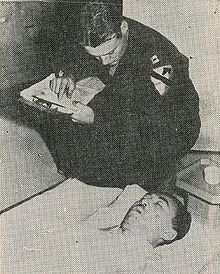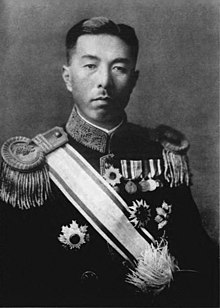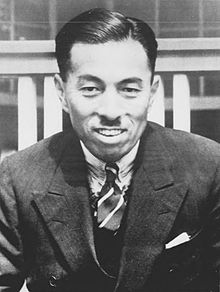Konoe Fumimaro
Prince Konoe Fumimaro ( Japanese 近衞 文 麿 , Konoe Fumimaro , also outdated Konoye ; * October 12, 1891 in Kōjimachi , Tokyo (today Chiyoda ); † December 16, 1945 ) was a Japanese politician and the 34th ( June 4, 1937 - January 5, 1939 ), 38th ( July 22, 1940 - July 18, 1941 ) and 39th ( July 18, 1941 - October 17, 1941 ) Prime Ministers of Japan and founder of the Taisei Yokusankai party .
Life
He was born into the ancient Japanese aristocratic Fujiwara clan , heir to the Konoe princely family . His father was the anti-Russian politician Konoe Atsumaro . His younger brother was the conductor and composer Konoe Hidemaro .
Shaped by his German and philosophy teacher Iwamoto Tei ( 岩 元 禎 ), he first began studying philosophy at the Imperial University of Tokyo , but then moved to the law faculty of the Imperial University of Kyoto , where he mainly studied sociology under the Marxist Kawakami Hajime . During his studies he translated Oscar Wilde's essay Socialism and the Soul of Man into Japanese and published it in the literary magazine of the Imperial University of Tokyo Shinshichō Issue 3 from 1914, which was then banned for a short time.
He entered politics in 1920 as a representative of the moderate line and protégé of Saionji Kinmochi and was therefore directed against the exercise of power by the army .
In the mansion , the upper house of the Reichstag , to which he automatically belonged as kōshaku ("Fürst / Herzog / Prince") from the age of 25 in 1916, he was Vice President from 1931 and President from 1933.
First term
In June 1937 he became Prime Minister of Japan in an attempt to counterbalance the growing power of the military . However, he himself became increasingly militaristic. After the beginning of the Second Sino-Japanese War , the incident at the Marco Polo Bridge in July 1937, and under pressure from the hardliners, his cabinet approved the expansion of operations in China and handed over independent management of the conflict to the military leaders, without the To leave government control.
In November, Konoe announced Japan's goal of reorganizing Asia, dubbed the " Greater East Asian Prosperity Sphere ". He pressured China to make concessions to end the war with Japan . On January 5, 1939, he resigned because of his inability to negotiate an end to the conflict with China. Hiranuma Kiichirō followed him as prime minister. On the same day Konoe was appointed chairman of the Secret Council , where he in turn replaced Hiranuma Kiichirō and both of them exchanged positions.
Second and third terms
After Yonai Mitsumasa's resignation in July 1940, Konoe - as a compromise candidate from radicals and conservatives - was again prime minister and resigned from his position as chairman of the Secret Council. In August, Foreign Minister Matsuoka Yosuke announced the plan previously worked out by the Army High Command to create a " Greater East Asian Prosperity Sphere ". In September, immediately following the Japanese occupation of the northern part of French Indochina , the three-power pact with Germany and Italy was signed. The driving force behind Japan's signing was rather the radical nationalists, represented by Matsuoka, who wanted to secure Japan's participation in a redistribution of the European colonies in Asia. For the moderate faction around Konoe, on the other hand, the treaty was primarily intended to provide reassurance against the resistance of previously uninvolved powers such as the USA and the Soviet Union to Japan's policies in China and Southeast Asia.
In order to further secure Japan's foreign policy position, the Konoe government sought a treaty guarantee of the neutrality of the Soviet Union and the USA. In the case of the Soviet Union, this was achieved with German support in April 1941 with the signing of the Japanese-Soviet Neutrality Pact . The negotiations with the USA turned out to be much more difficult. Based on incorrect information received from the Japanese embassy in the United States, Konoe hoped for a personal summit meeting with President Roosevelt , which never took place. Konoe's government had no part in the German decision to invade the Soviet Union . After this began at the end of June 1941, the joint conference of the Cabinet and the Imperial High Command decided to concentrate the war effort on gaining supremacy in Southeast Asia ("southern strategy"). Konoe's opponent Matsuoka, who refused to bow to this decision, was removed from the cabinet a little later when the cabinet resigned and all ministers except him were reappointed. In late July, the Japanese forced French permission to station troops on military bases in southern Indochina. The US government then imposed an oil and trade embargo and froze Japanese balances with US banks. The government of Great Britain and the government-in-exile of the Netherlands followed suit. Because of the rapidly decreasing oil supplies, the general staff of the Japanese fleet demanded that the war be opened in the same year if the negotiations were unsuccessful. After the agreed deadline, Konoe's government resigned on October 17, seven weeks before Japan's attack on Pearl Harbor . Konoe's successor was the previous Army Minister Tōjō Hideki .
Last years of the war, post-war years and death

Konoe played a role in the fall of the Tōjō government in 1944, and in February 1945 he advised Emperor Hirohito to begin negotiations aimed at ending World War II . After the start of the American occupation , he served in the cabinet of Prince Higashikuni Naruhiko , the first post-war government. After their resignation in October 1945, he was encouraged by the occupation authorities under Douglas MacArthur to begin preparatory work for a new Japanese constitution . However, he was soon dropped by his interlocutors, including MacArthur's political advisor George Atcheson Jr. On December 6, his name appeared on a list of Class A war criminals who were almost certain to be convicted and executed. Ten days later, at night, in which he was to face the occupation authorities, he committed with sodium cyanide suicide . It was 1945, exactly 1,300 years after his ancestor Fujiwara no Kamatari gained a position of power through a coup against the Soga clan. This symbolically ended the era of the Fujiwara rulers.
His son Fumitaka died in a Russian camp in 1956. His widow Masako caused a certain stir when she personally picked up his ashes in Moscow on October 1, 1958.
His grandson, Hosokawa Morihiro , was Prime Minister from August 1993 to April 1994 .
Individual evidence
- ↑ Kazuo Yagami: Konoe Fumimaro and the Failure of Peace in Japan 1937-1941. A Critical Appraisal of the Three-Time Prime Minister . McFarland, 2006, ISBN 0-7864-2242-4 , pp. 15 .
- ↑ Berend Wispelwey (Ed.): Japanese Biographical Archive . Fiche 167, KG Saur, Munich 2007, ISBN 3-598-34014-1 .
Web links
- Biography Konoes (English)
- Newspaper article about Konoe Fumimaro in the 20th century press kit of the ZBW - Leibniz Information Center for Economics .
- National Parliamentary Library : 日本国 憲法 の 誕生 ( Nihon-kokukenpō no tanjō , "Birth of the Japanese Constitution"): 人物 紹 介 / Historical Figures (Japanese / English)
| personal data | |
|---|---|
| SURNAME | Konoe, Fumimaro |
| ALTERNATIVE NAMES | 近衞 文 麿 (Japanese) |
| BRIEF DESCRIPTION | Japanese Prime Minister |
| DATE OF BIRTH | October 12, 1891 |
| PLACE OF BIRTH | Kōjimachi , Tokyo (now Chiyoda ) |
| DATE OF DEATH | December 16, 1945 |


